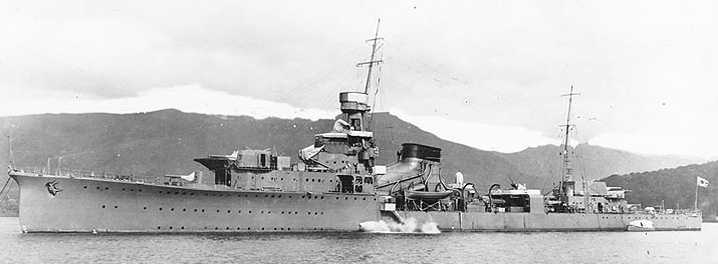
This weapon was the standard secondary gun for most of Japan's capital ships built or planned between 1915 and 1922 and was the primary gun on light cruisers built prior to 1930. It was also the most numerous coastal defense gun used during World War II.
This gun was adopted in 1914 as a replacement for the earlier 6" (15.2 cm) guns as it was felt that its lighter shells were better suited for manual handling by the average Japanese crewman.
Earlier guns were built with four layers and wire-winding (Model No. II), but later guns were of built-up construction without the wire (Model No. IV). Used Welin screw breech blocks with a three-motion breech mechanism.
Redesignated in centimeters on 5 October 1917.
| Designation | 5.5"/50 (14 cm) 3rd Year Type (Model 1914)
14 cm/50 (5.5") 3rd Year Type (Model 1914) Official Designation: 50 caliber 3rd Year Type 14 cm Gun |
|---|---|
| Ship Class Used On 1 | Japan
Capital Ships: Ise, Nagato, Amagi, Kaga, Kii and "13" classes Carrier: Hôshô Light Cruisers: Tenryû, Kuma, Nagara, Sendai, Yubari and Katori classes Seaplane Carrier: Nisshin Minelayer: Okinoshima Submarine Tenders: Jingei class China
|
| Date Of Design | 1914 |
| Date In Service | about 1916 |
| Gun Weight | 5.5 - 5.6 tons (5,600 - 5,700 kg) |
| Gun Length oa | 284.8 in (7.235 m) |
| Bore Length | 275.6 in (7.000 m) |
| Rifling Length | 235.0 in (5.968 m) |
| Grooves | (42) 0.55 in deep x 0.252 in (1.40 mm x 6.40 mm) |
| Lands | 0.160 in (4.07 mm) |
| Twist | Uniform RH 1 in 28 |
| Chamber Volume | 1,404 in3 (23 dm3) |
| Rate Of Fire | 6 to 10 rounds per minute, depending upon the rate of supply 3 |
- ^Many capital ship classes were cancelled, scrapped or converted to aircraft carriers during the 1920s as a result of the Washington Naval Limitation Treaty. As a result, only the Ise and Nagato classes actually saw service with this weapon. These cancellations did free up many guns for use in coastal batteries, as mentioned above.
- ^The Chinese light cruiser Ning Hai was built in Japan and her near sister Ping Hai was built in China with Japanese assistance. These ships were armed with Japanese weapons including six 14 cm/50 Type 3 guns. Both ships were sunk and captured by the Japanese in 1937. They were then salved and sent to Japan where they lay idle for several years. In 1943 they were converted into kaibôkans (convoy escort ships). The 14 cm/50 guns were removed as part of the modifications and replaced with a lighter main armament consisting of two 12 cm/45 10th Year Type guns. Commissioned into the Japanese Navy as Ioshima and Yososhima, they were both sunk by USN forces by late 1944.
- ^All ammunition transfers from the hoists to the guns were manual, so the ROF of the individual guns was affected by how far the ammunition passers had to travel. It is noted in "Japanese Cruisers of the Pacific War" that the 6-gun, 3,500 ton Yubari had a faster ROF than did the 7-gun, 5,500 ton cruisers as her gun mountings were spaced closer together and thus the ammunition passers had a shorter distance to travel.
| Type | Bag |
|---|---|
| Projectile Types and Weights 1a | Capped Common: 83.8 lbs. (38.0 kg)
Capped Common Mods 1 & 2: 83.8 lbs. (38.0 kg) Common Type 0 HE 2a: 83.8 lbs. (38.0 kg) Common Type 2 HE: 83.8 lbs. (38.0 kg) ASW 3a 4a: 92.4 lbs. (42.0 kg) Common Type 3 IS 5a: 83.8 lbs. (38.0 kg) |
| Bursting Charge | Capped Common: 4.4 lbs. (2.0 kg)
Capped Common Mods 1 & 2: 4.4 lbs. (2.0 kg) Common Type 0: 6.3 lbs. (2.86 kg) Common Type 2: 5.7 lbs. (2.60 kg) ASW: 6.3 lbs. (2.86 kg) |
| Projectile Length | Capped Common Mods 1 & 2: 21.65 in (55.0 cm)
Common Type 0: 21.81 in (55.4 cm) Common Type 2: 21.81 in (55.4 cm) ASW: 22.56 in (57.3 cm) Others: N/A |
| Propellant Charge 6a | All except ASW
22.8 lbs. (10.33 kg) 40C or 50C 24.2 lbs. (10.97 kg) 37DC ASW: N/A |
| Muzzle Velocity | All except ASW: 2,789 to 2,805 fps (850 to 855 mps)
ASW: 820 fps (250 mps) |
| Working Pressure | 18.4 to 18.5 tons/in2 (2,900 to 2,910 kg/cm2) |
| Approximate Barrel Life | 500 - 600 Rounds |
| Ammunition stowage per gun | Ning Hai: 120 rounds (space was provided for a maximum of 200 rounds)
Others: N/A |
- ^Capped Common shells were introduced in 1916 and were replaced by Capped Common Mods 1 & 2 in 1934. Common Type 4 was introduced in 1932 and was replaced by Common Type 0 in 1940.
- ^Common Type 0 HE was supplied with time fuzes for AA defense. US Naval Technical Mission to Japan report O-19 says that this round had an effective radius of 28.6 yards (26 m) but this seems to be optimistic.
- ^The ASW projectile was flat nosed. ASW rounds were issued in 1943 following extensive testing. Penetration performance not available.
- ^Minimum range of ASW shell is given as 875 yards (800 m). Ranges less than this tended to ricochet.
- ^IS is my abbreviation for the incendiary shrapnel round (sankaidan) intended for AA use.
- ^The propellant charge was in a single bag with a 2.1 oz (60 gm) black powder igniter.
| Elevation | Range |
|---|---|
| 20 degrees | 17,280 yards (15,800 m) |
| 25 degrees | 19,140 yards (17,500 m) |
| 30 degrees | 20,890 yards (19,100 m) |
| 35 degrees | 22,500 yards (20,574 m) |
| Elevation | Range |
|---|---|
| 40 degrees | 4,590 yards (4,200 m) |
Minimum range of ASW shell is given as 875 yards (800 m). Ranges less than this tended to ricochet.
| Designation | Single Casemate Mounts
Ise (20) 1b, Nagato (20) 2b, Kaga (20), Kii (16-20) and Amagi (16): N/A Single Pedestal Mounts 3b
4b Twin Mounts 7b Ning Hai (3): A |
|---|---|
| Weight 9b | Single Mounts: About 20 tons (21 mt)
Twin Mounts: About 49 tons (50 mt) |
| Elevation | Single Casemate Mounts
Ise 10b: -7 / +20 degrees Nagato 11b: -7 / +25 degrees Single Pedestal Mounts 12b Twin Mounts
Ning Hai: -7 / +30 degrees |
| Elevation Rate | Single Mounts: 8 degrees per second - Manual operation, only
Twin Mounts: 6 degrees per second |
| Train | Capital Ships: About +70 / -70
Light Cruisers: +150 / -150 degrees |
| Train Rate | Single Mounts: 8 degrees per second - Manual operation, only
Twin Mounts: 4 degrees per second |
| Gun recoil | N/A |
| Loading Angle | Any angle up to +20 degrees (hand ramming) |
- ^During modernization in 1935, four 14 cm/50 guns were removed from the Ise class. All remaining 14 cm/50 guns were removed from Ise and Hyuga when they were converted to hybrid carriers in 1943.
- ^During modernization in 1934, the Nagato class had two 14 cm/50 guns removed. Nagato had a further two guns removed in June 1944 in order to allow more 25 mm Type 96 AA guns to be fitted.
- ^Single mountings on cruisers had bucket chain hoists which brought both projectiles and propellant up to the weather deck. All transfers to and from the magazines, hoists and guns were performed manually. Single mounts were entirely hand worked.
- ^Most surviving 5,500 ton cruisers lost two of their stern guns in 1942-43 in order to fit a twin 12.7 cm/40 Type 89 mounting and additional 25 mm Type 96 AA guns. Isuzu was converted to an anti-aircraft cruiser in 1944 by removing all of her 14 cm/50 guns and replacing them with three twin 12.7 cm/40 Type 89 mountings along with 11 triple and 17 single 25 mm Type 96 AA guns.
- ^The Kuma class cruisers Kitakami and Ooi had their three aft 14 cm/50 guns removed in 1941 and given ten quadruple Type 92 torpedo tube mounts for 61 cm torpedoes in their place. It had been planned to remove all 14 cm/50 guns from these two ships and replace them with two 12.7 cm/40 (5") Type 89 twin mountings, but a shortage of these mounts led to the ships retaining their four bow 14 cm guns. In 1944 Kitakami was further modified into a Kaiten (suicide torpedo) carrier. Her remaining four 14 cm/50 guns and all torpedo tubes were removed and replaced with two twin 12.7 cm/40 (5") Type 89 mountings and fittings to carry eight Kaitens.
- ^Yubari had both single guns removed during a refit in 1943-44. The bow gun was replaced by a 12 cm/45 (4.7") Type 10 gun while the after gun was replaced by a triple 25 mm Type 96 AA mounting.
- ^Twin mounts were provided with electro-hydraulic gear for training and elevation, but could also be operated by hand if necessary. Bucket chain hoists brought shells and propellant up to the level below the mounting and were transferred to a hoisting tube going up to the gunhouse which rotated with the gun house. For Yubari, these same bucket hoists supplied the single mountings as well.
- ^The 14 cm/50 Type 'A' twin mounting served as a model for the 12.7 cm/50 (5") Type 'A' twin mountings used on the "Special" destroyers of the Fubuki class.
- ^A Note on Sources: "Naval Weapons of World War Two" says that the twin mounts on the Katori class weighed 48 tons (49 mt) while the twin mountings on the other ships were 35.9 to 36.9 tons (36.5 to 37.5 mt). This data appears to be sourced from US Naval Technical Mission to Japan report O-47(N1). Campbell credits this weight difference to the Katori class having thick 5 cm (2 inch) shields versus 1 cm (0.4 inch) shields on the other ships, although shield thickness is not noted in O-47(N1). However, this weight difference and level of protection is not supported by "Japanese Cruisers of the Pacific War," which states that all ships had a 1 cm (0.4 inch) shield and weighed 49 tons (50 mt). This weight seems consistent with the single mounting at 20 tons (21 mt) as reported in this same source, as the single mounting was an open back type while the twin was a fully enclosed design. I also find it difficult to believe that the Katori class would have had such a thick gun shield as they were designed and built as training cruisers. These ships lacked all but splinter protection everywhere else, as thicker armor would have taken weight away from their primary purpose of training. For these reasons, I believe that "Japanese Cruisers of the Pacific War" is probably the correct source to use for these mountings.
- ^During modernizations in 1935, the gun elevation range for the Ise class was increased to -7 / +30 degrees.
- ^During modernization in 1934, the gun elevation range for the Nagato class was increased to -7 / +35 degrees.
- ^Some cruiser single mounts were restricted to a minimum elevation of -5 degrees depending upon location.
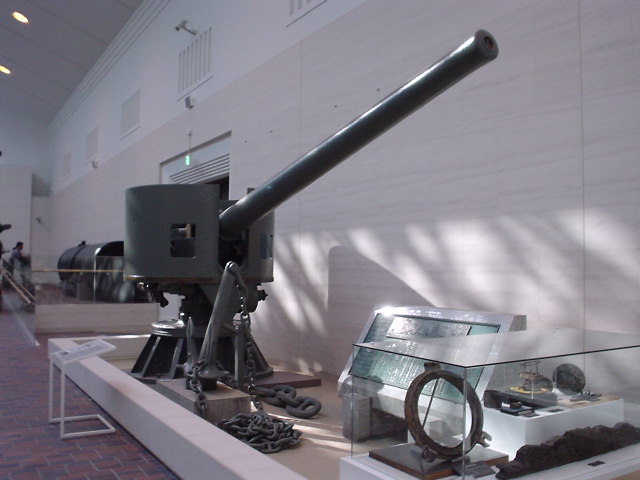
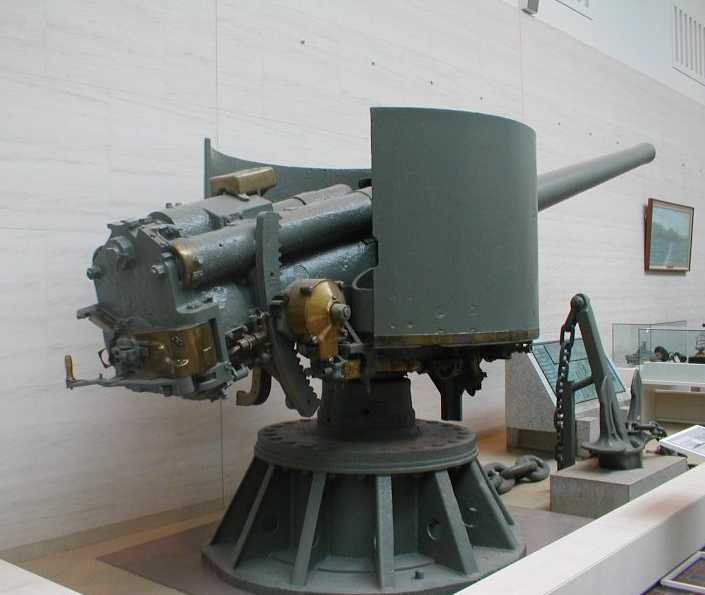
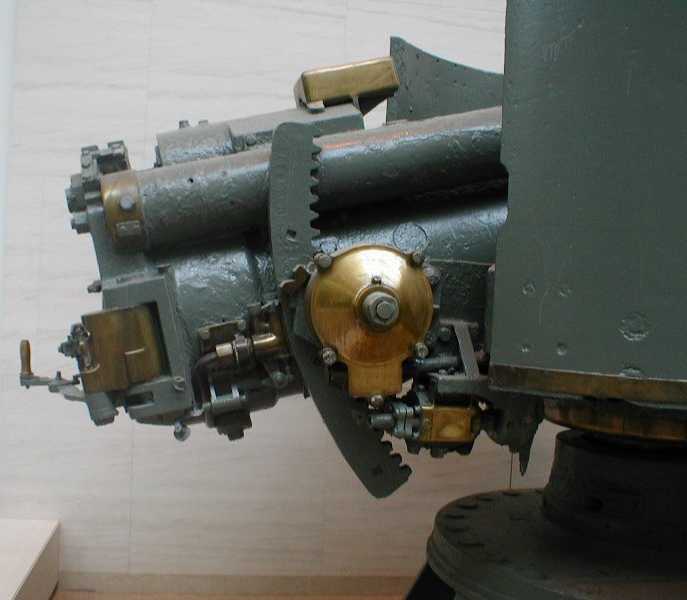
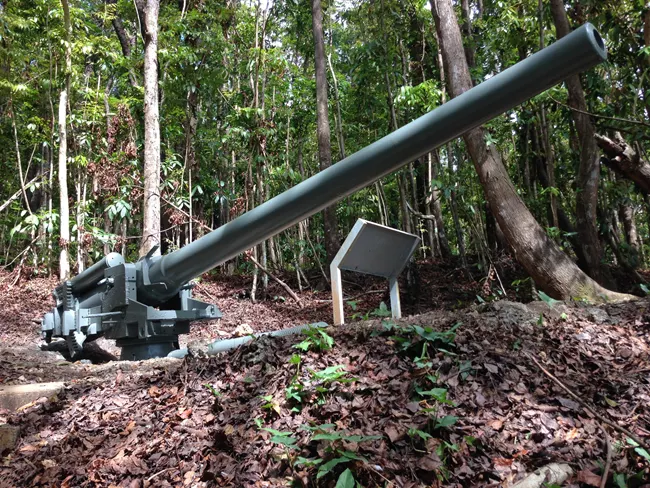
"Naval Weapons of World War Two" by John Campbell
"Japanese Cruisers of the Pacific War" by Eric Lacroix and Linton Wells II
"The Imperial Japanese Navy in the Pacific War" by Mark E. Stille
"Cruisers of World War Two" by M.J. Whitley
---
US Naval Technical Mission to Japan report O-19: Japanese Projectiles General Types
US Naval Technical Mission to Japan report O-47(N1): Japanese Naval Guns and Mounts, Article 1 - Mounts under 18"
US Naval Technical Mission to Japan report O-54(N): Japanese Naval Guns
---
National Park Service "War in the Pacific" website
23 August 2007 - Benchmark
23 September 2010 - Added notes regarding elevation and weight of twin mounts
05 March 2015 - Added notes regarding removal of guns during refits
12 July 2015 - Added note regarding guns removed from Nagato and Ise class
25 September 2016 - Converted to HTML 5 format and added note regarding rearming of light cruisers
21 March 2019 - Reorganized notes, added note regarding time fuzes on Common Type 0 HE
23 April 2019 - Added ASW range table
26 September 2020 - Redid ASW range table
23 October 2022 - Added use on Chinese Ning Hai class, notes on rearmament of light cruisers and note on ROF
19 August 2023 - Added photograph of gun on Guam
28 October 2023 - Added comment on breech mechanism
